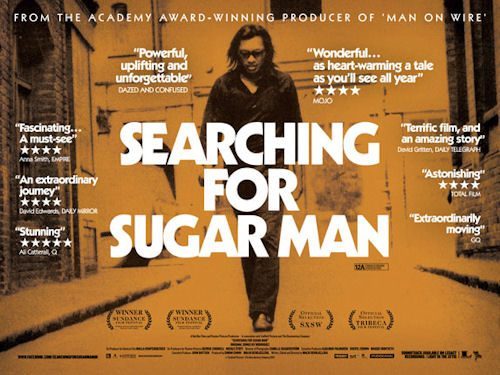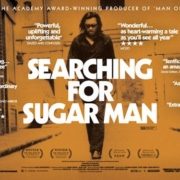SEARCHING FOR SUGAR MAN
Dead Man Singing:
Searching for Sugar Man

What if Elvis weren’t the King? What if it were a Chicano folk singer you never heard of? What if Dylan weren’t the Poet Laureate of Rock & Roll? What if it were a Detroit troubadour who inspired the most oppressed people in the third world to hear the Chimes of Freedom flashing? What if Nelson Mandela were not the only hero of the South African freedom movement? What if this same troubadour found himself inexplicably to have inspired a generation of Afrikaners to accept the necessity of ending Apartheid?
Then you’d know how I felt upon coming out of the screening of Director Malik Bendjelloul’s Searching for Sugar Man. To call it a documentary begs the question; for if it is true then it is also one of the more fantastic tales since Jules Verne’s Around the World in 80 Days or Lewis Carroll’s Alice in Wonderland. But I met three of its disciples—outside the Landmark Theatre on Pico Blvd. Call them Matthew, Mark and Luke; they were so eager to vouch for the authenticity of this fabulous tale they made a believer out of me—an avowed atheist and skeptic.
More to the point, if it is true the standard history of rock & roll needs to be substantially revised. That history, told in countless versions by the best rock critics of our time from Greil Marcus to Robert Hilburn, begins with Elvis recording That’s All Right at Sun Studios in Memphis in 1956, bringing a white audience to black rhythm & blues; DJ Alan Freed giving it the name of rock & roll a year later; Buddy Holly completing the symbolic metamorphosis of black music into white by being mistaken for a black performer by a white booking agent who confoundedly sent him to Harlem’s Apollo Theatre; “the day the music died” on February 3, 1959, when Holly, Richie Valens and The Big Bopper died in a plane crash near Mason City, Iowa; the British Invasion of 1964, when The Beatles sang I Wanna Hold Your Handon the Ed Sullivan show; and Bob Dylan getting booed at the Newport Folk Festival in 1965 when first plugged in his Fender Stratocaster and created folk rock. There are other important moments and figures, of course, but those the era-defining psychic upheavals in the accepted history of the most important American music in the second half of the 20th Century.
Until Searching for Sugar Man. For an essential figure—you heard me right—essential figure in that history has only now been discovered, or rediscovered, and his rightful due been recognized. His full name is Sixto Rodriquez, and he recorded his first of only two albums in 1971 in Detroit, but his music is spiritually as far from Motown as you can get. It is closer to the Mississippi Delta, and his story as strange as one of its modern 1960s rediscoveries—Mississippi John Hurt, who was similarly rediscovered forty years after he made his first recordings by bluegrass mandolin virtuoso and folklorist Ralph Rinzler—by the chance realization of his hometown Avalon, Mississippi in one of those early recordings. Guess what? John Hurt was still living in Avalon in 1963—and found that he had a whole new audience readymade for him in the folk revival that was launched in 1958 with the Kingston Trio’s recording of Tom Dooley.
The saga recounted in Searching for Sugar Man has a dramatic turning point very much in keeping with the search for Mississippi John Hurt. Except that the music enthusiasts who wanted to find Rodriguez came from half of world away—Cape Town, South Africa, where it turns out that Rodriquez’s first album, Cold Fact—which sold a grand total of 6 copies in the US before disappearing without a trace—had unaccountably become a massive hit album in South Africa—selling over 4 million copies—and all from a bootleg copy of the American release that a young woman left behind when she visited the country in the ‘70s, while Nelson Mandela was in prison on Robben Island.
Who knew? It fell in the hands of record store owner Stephen “Sugar Man” Segerman—the second “Sugar Man” of the title, named for one of Rodriguez’s most popular songs—who re-released the album on a local label, one of three similar bootleg versions of the album to make their way up the South African sales charts, while it was being studiously ignored in his own country.
Did any of the royalties from these multimillion-dollar sales figures make their way back to Detroit into the artist’s hands? Don’t ask. But not for the usual reason: nobody would have known where to send the money. For the strangest part of this stranger in a strange land story is that the very promoters, fans and eventually fellow South African musicians who worshipped his music also assumed Rodriquez was dead—by his own hand, and during a concert no less, some convinced he had shot himself in the head, and others that he set himself on fire—akin a Buddhist monk in Vietnam protesting the war.
He literally was a dead man singing.
So enthralled were they with his artistic legend that these same Afrikaners finally found each other out and began the search in earnest to reconstruct where in fact it came from, and who was the man who belonged to the name in the copyright notices for the songs, variously called “Sixto Rodriguez” and “Jesus Rodriquez.” (The name on the front of the albums—both Cold Fact and his second album, Coming From Reality—was just his last name, Rodriguez.)
That led these South African Sherlock Holmes’s to the U.S. But where in the U.S.? There was precious little to go on, but one of these musical sleuths noticed a place name in the lyrics of these powerful autobiographical songs, just as Mississippi John Hurt had written a song about Avalon, “my home town.”
The place name Rodriquez had dropped into his song was Dearborn, which they found to be a suburb of Detroit, whose gritty city streets had inspired his stark view of reality. South Africa’s own stark reality had met its American counterpart—one of the starkly segregated Northern cities that burned in the race riots of the late 1960s. But somehow Rodriguez had infused a dark folk sensibility into his tales of urban street life—thirty years before Rap and Hip Hop would drive home their deep-seated anger and pain.
His songs missed the American audience of 1971, which had settled comfortably into the soft “singer-songwriter” comfort zone of James Taylor, Joni Mitchell and Cat Stevens.
And yet they spoke profoundly to a society enmeshed in a life-and-death struggle with Apartheid and Mandela’s Black National Congress. It gets curiouser and curiouser.
Imagine their amazement when they finally track down the Black American Sussex Records label owner Clarence Avant who put the lie to their misguided belief that Rodriguez had committed suicide on stage, and was alive and well and still living in Detroit. Suddenly the movie takes on a whole new dimension: they are about to walk headlong into their legend’s real life—and it is not a pretty sight.
It turns out their superstar is as far removed from their imaginary life as he could possibly be: he makes his living from hard labor—but hard labor he takes great pride in, for as he puts it, “there is no substitute for reality.” And his reality is as real as it gets–carrying refridgerators on his back.
Surprise: he meant what he said in his second album’s title—Coming From Reality—it wasn’t just a clever turn of phrase or appealing poetic image. It defined his view of life.
When the director confronts him with the possibilities of the life he left behind as a potential music star, Rodriguez is both utterly self-effacing and self-assertive when he assures the filmmaker that he is not so sure he left a better life behind. He likes his current life just fine, thank you; that is how he raised three daughters as a single father.
The filmmaker wisely lets his daughters tell his remarkable post-recording industry life story, and with great skill incorporates his eldest daughter Eva Rodriguez’s homemade video of the film’s final act—the “return” of the real-life Rodriguez to the new South Africa whose history he—completely unknown to himself or others in America—had a profound role in shaping. For one after another filmmaker Malik Bendjelloul finds fellow countrymen who credit those two early albums with giving them The Times, They Are a-Changing inspiration that Bob Dylan gave us. Only to hear them tell it, “Dylan was mild in comparison with Rodriguez.” And, by the way, he was also “bigger than Elvis.”
Well, I’ll leave that part of it for others to judge. One need not make invidious comparisons between our folk and rock heroes and South Africa’s, even if their heroic measure of a man was an unknown Chicano Detroit folk singer.
This is a story and a movie—and preeminently a soundtrack—you won’t soon forget. Unless you are one of six prescient Americans who bought his records at the source you will not have heard these songs before.
And they will make you wonder why—just as Rodriguez’s great song I Wonder gives you the language to understand.
For there were other questions blowing in the wind besides the ones Dylan asked; Rodriguez asked some just as profound and equally troubling—great artists both. We are much indebted to the profound determination that brought this man back to life. It was a revelation to meet three of Rodriguez’s biggest Afrikaner fans at the very screening I happened to attend. I noticed the same thing that they were somewhat embarrassed about in the movie’s great climactic scene when Rodriguez walks onto the Cape Town stage in 1998 to meet the fans whose music had meant so much to them nearly 30 years before. As clear and moving as it is to see a star being born, where were the black South Africans in the audience I wondered, echoing the words of Rodriguez’s song? The audience was all white—too white to be an adequate symbol for an artist who helped make those walls of Apartheid come tumbling down.
They carefully explain to me that even post-Apartheid their country is not functionally integrated; Black South Africa has its own cultural heroes and own music—of the sort Paul Simon went searching for when he made Graceland.
I didn’t have the heart to tell them-here too. So far we’ve come; and still so far to go.
David Letterman was paying attention to this film’s portrait of an artist as young man, and invited the old man he had become onto his show as the musical guest. He gave a great performance.
F. Scott Fitzgerald famously said there are no second acts in American lives; Sixto Rodriguez proves him wrong. I hope he finds time between the hard labor that supports his family to occasionally seek out musical opportunities to continue to share his music with the world. This time around the world will be listening.
Ross Altman may be reached at Greygoosemusic@aol.com.













